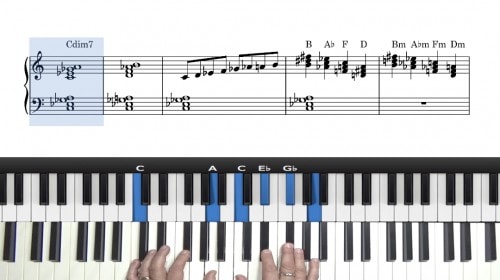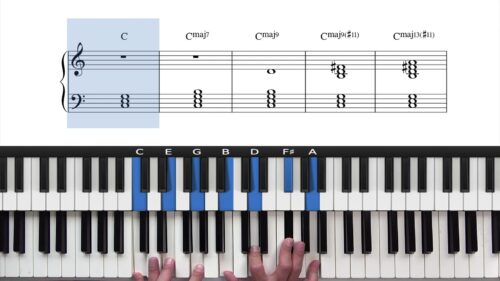Triad Based Improvisation
Welcome to this lesson on minor improvisation using triad shapes. It’s important to understand that ‘improvising using triad shapes’ doesn’t mean that we have to exclusively play the notes of the triad, but rather we are using the triad shape as a framework around which we construct our improvised melodies.
Minor Scale Similarities
An interesting point before getting started is that the first 5 notes of all of the minor scales are the same 5 notes. The natural minor, harmonic minor, melodic minor – all start with the same 5 notes.
Based on this analysis, these 5 notes are important for us both to be able to visualise, and to create melodies with. The other notes of the scale – which are the 6th and 7th notes – are the ‘flexible notes’ that we can add to create different colours and flavours above the core minor sound.
6 Step Improvisation Framework
After analysing the minor scale we then introduce a 6 step improvisation framework for creating beautiful improvised melodies over any minor chord:
- Start with just the triad
- Add the 4 or 11 to the basic triad
- Add the 2 or 9 to the basic triad
- Introduce bigger intervals such as 4ths, 5ths, and 6ths.
- Decorate the melody with turns and grace notes
- Practice leaving space to let your improvised melodies breath
In the next lesson we are will introduce the other flavours which are the melodic minor flavour, the harmonic minor flavour, and we will touch upon blues scale improvisation.
We will also extend the triad improvisation principle and apply it to the 251 progressions in the A section which are a 251 in D minor, and a 251 in F major.
Practice Tips
-
Notice that the first 5 notes of all of the minor scales are the same 5 notes.
-
View the different minor scales simply as 'different shades' of the same colour.
-
Apply the 6 step improvisation framework to the minor line clichés in D Minor and G Minor.
-
As a homework exercise, apply this to a different minor chord in a different tune, for example C Minor in "My Funny Valentine".







I’m enjoying these triad-based improv exercises (here and in the next 2 sections) immensely. It’s very beautiful and meditative. I would really appreciate some help on finding the best smooth fingering. Any chance you could include that somewhere?
Hi Wendy, thanks for letting me know and I’m glad you are enjoying the lessons.
Take a listen to the recordings I have compiled in this playlist: open.spotify.com/playlist/2htZ7H7QlDD1ncV6aFY5g6?si=b6d6a96caa9f4319 – virtually all of the piano solos incorporate triad-based lines with the colour tones.
Giving an exact fingering is tricky as it depends on what other colour notes are being used, for example the major 7th/melodic minor sound, the harmonic minor flavour, and the blues scale/blue note flavour.
Take a skim through the improvised solos of the recordings in the playlist and pick 2 or 3 that you really like and try to play along with the recordings. I find this is the best way to decide on a fingering that works for you, and a fingering that also allows you to emulate the recording as close as possible (which is the goal).
I have recorded 3 more lessons which finish the harmony module for this course, I need to record the blues scale improv lesson, and then I’d like to pick a few of these recordings and analyse them in lesson-format to show how the concepts that we have covered are present in the improvised solos.
The Eddie Higgins Trio recording is a nice example of triad-based improv with the blue note colour.
I really like the piano solo in the Scott Hamilton recording, it really stretches on the time which I like.
The Beegie Adair recording has some lovely melodic minor and harmonic minor melodies, and again she quotes a lot of triad shapes in her lines.
I’d like to cover those 3 solos and break them down in detail. The Eddie Higgins Solo recording is very beautiful too. He uses lots of 3rd-interval melodies.
More updates to follow on this course.
Cheers,
Hayden
Great lesson Hayden. This 6 step-method is amazingly effective: I think it’s the first time I have this feeling of really improvising (ie. not repeating ready-made patterns and motives) with fluidity. Is there a similar method for major harmony?
Hi Laurent,
Thanks for the feedback and I’m glad to hear that the ideas and concepts are useful.
Yes there is a similar method for major harmony, which I will add to this course. The technique works over major 251 progressions. For example, for the 251 in F major in bars 7 and 8 of this tune, we have the chords G-7, C7, and Fmaj7. The technique is to simply use the F triad, or the notes of F6 as the focus notes of our improvisation. This works well because the harmony is moving to Fmaj, the 1 chord, and so when our melody outlines these notes it fits with the resolution of the harmony.
I recommend to start trying to improvise over the 251 in Fmajor with just the notes of an F triad, or F6 chord, and then gradually start to introduce other tones such as alterations of the 5 chord and chromaticism also works well.
The same principle also works well over the minor 251s, for example in bars 4 and 5, we have a 251 in D minor which is E-7b5, A7, and D-. I recommend trying to improvise over this progression using just the notes of the D- triad, and you will hear that it works fine. You can then touch upon the other colours such as the major 7th of D (which is also the 3rd of A7).
I will create more lessons on this shortly and add to this course as I had planned to. I wasn’t sure if the concepts I covered were helping and making sense for everyone, but your feedback is very useful and I will add the new lessons shortly, most likely finished by next week.
I hope that helps Laurent. In the interim, experiment with the suggestions above and let me know if I can help further.
Cheers,
Hayden
Excellent lesson. Very clear explanations.
Thanks Cornelius – I’m glad you enjoyed it.
As mentioned, this basic ‘framework’ for improvising over minor harmony can be heard in both the Eddie Higgins version and Tommy Flanagan’s piano solo of this tune that we shared in the forum. They both play improvised lines that are clearly based around the triad shape with the 2/9 and 4/11 colour tones added.
I can’t say for certain that these guys are thinking of their solos in this way, but personally it helps me to analyse and conceptualise their solos into something that I can then apply to my playing and apply to minor chords in other situations.
Cheers,
Hayden
Hi Hayden. I’ve been working through the course which gives some excellent methods for improvising over minor chords as well as the minor 251 parts of In ‘A Sentimental Mood’. I’d like to continue on in learning how to improvise over the whole tune which includes dominant 7ths, major 251s, major 7ths, etc. I’ve tried typing ‘improvisation’ into your Search option and, not surprisingly, lots of different courses show up. Would you please recommend which course(s) to start with to develop the skills to improvise over major chords and major progressions.
Cheers,
Greg
Hi Greg,
I’m glad to hear that you are enjoying the course and please excuse my late reply.
For more improvisation principles and techniques, I recommend checking out the following 2 courses:
1. Cocktail Piano Improvisation: pianogroove.com/jazz-piano-lessons/cocktail-improvisation-for-beginners/
2. Ballad Voicings, Fills and Runs: pianogroove.com/jazz-piano-lessons/ballad-voicings-fills-improv/
In both of these courses, there is a dedicated improvisation module where we cover important principles such as targeting chord tones, using arpeggios, targeting alterations over dominant chords, altered arpeggios, and blues scale material. I suggest combining these techniques with the minor improvisation principles covered in this course. That will give you a wider palette of improvisational techniques to use over jazz standards.
I plan to add more lessons to this course shortly, so keep an eye on this course page. We will explore improvisation over dominant 7ths, major 251s, and major 7th chords.
Please let me know if I can help further and enjoy the lessons.
Cheers,
Hayden.
It’s been 2 years since I commented on this lesson. Greg’s comment took me back, and I’m enjoying the lessons just as much. I realize that Leon Russell’s “A Song for You” is a perfect example of the what’s covered in the lesson. Unfortunately my computer skills are not good enough for me to upload a copy of the song, but if you have a way to access it, check it out.
Hi Wendy,
I’m glad to hear you’re enjoying the lessons.
I will check out Leon Russell’s “A Song for You” and try to incorporate this into an upcoming seminar.
Talk soon,
Hayden